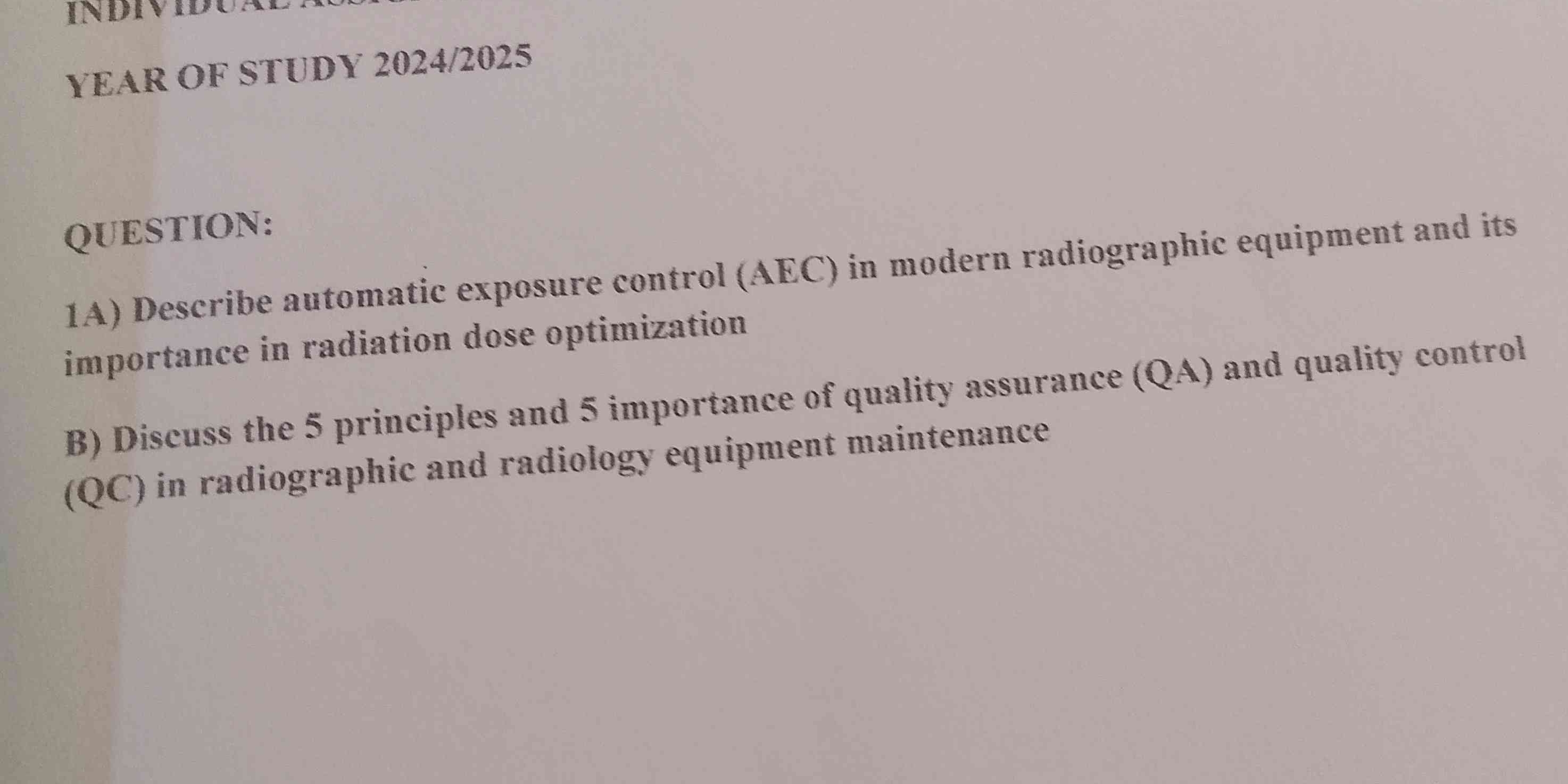1A) Describe automatic exposure control (AEC) in modern radiographic equipment and its importance in radiation dose optimization. B) Discuss the 5 principles and 5 importance of qu... 1A) Describe automatic exposure control (AEC) in modern radiographic equipment and its importance in radiation dose optimization. B) Discuss the 5 principles and 5 importance of quality assurance (QA) and quality control (QC) in radiographic and radiology equipment maintenance.

Understand the Problem
The question consists of two parts: the first part asks for a description of automatic exposure control in radiographic equipment and its significance in managing radiation dosage. The second part requests a discussion on the principles and importance of quality assurance and control in maintaining radiological equipment. This indicates a focus on radiography and its related safety measures.
Answer
AEC optimizes radiation dose and image quality. QA/QC ensures safety, quality, compliance, and cost-effectiveness in radiology.
1A) Automatic Exposure Control (AEC) is a system in modern radiographic equipment that automatically adjusts exposure settings to ensure optimal image quality while minimizing radiation dose to the patient. It helps reduce 'dose creep' by stopping exposure once sufficient radiation is received.
1B) 5 Principles of QA and QC:
- Accuracy: Ensuring all measurements are correct.
- Consistency: Maintaining stable performance over time.
- Precision: Focusing on detailed and repeatable measurements.
- Timeliness: Performing tests regularly to catch issues early.
- Documentation: Keeping detailed records of tests and maintenance.
5 Importance of QA and QC:
- Enhancing patient safety by reducing exposure.
- Maintaining diagnostic image quality.
- Reducing equipment downtime and associated costs.
- Ensuring compliance with regulations.
- Building trust in radiological services.
Answer for screen readers
1A) Automatic Exposure Control (AEC) is a system in modern radiographic equipment that automatically adjusts exposure settings to ensure optimal image quality while minimizing radiation dose to the patient. It helps reduce 'dose creep' by stopping exposure once sufficient radiation is received.
1B) 5 Principles of QA and QC:
- Accuracy: Ensuring all measurements are correct.
- Consistency: Maintaining stable performance over time.
- Precision: Focusing on detailed and repeatable measurements.
- Timeliness: Performing tests regularly to catch issues early.
- Documentation: Keeping detailed records of tests and maintenance.
5 Importance of QA and QC:
- Enhancing patient safety by reducing exposure.
- Maintaining diagnostic image quality.
- Reducing equipment downtime and associated costs.
- Ensuring compliance with regulations.
- Building trust in radiological services.
More Information
AEC systems are crucial in preventing overexposure, commonly referred to as 'dose creep,' and play a vital role in patient safety. QA and QC ensure the reliability and effectiveness of diagnostic equipment in medical settings.
Tips
A common mistake is confusing QA (broad focus on process) with QC (specific testing focus). Ensure a clear distinction.
Sources
- Automatic exposure control | Radiology Reference Article - radiopaedia.org
- Guide for Radiation Safety/Quality Assurance Programs - health.ny.gov
- Acceptance Testing and Quality Control of Digital Radiographic Equipment - aapm.org
AI-generated content may contain errors. Please verify critical information